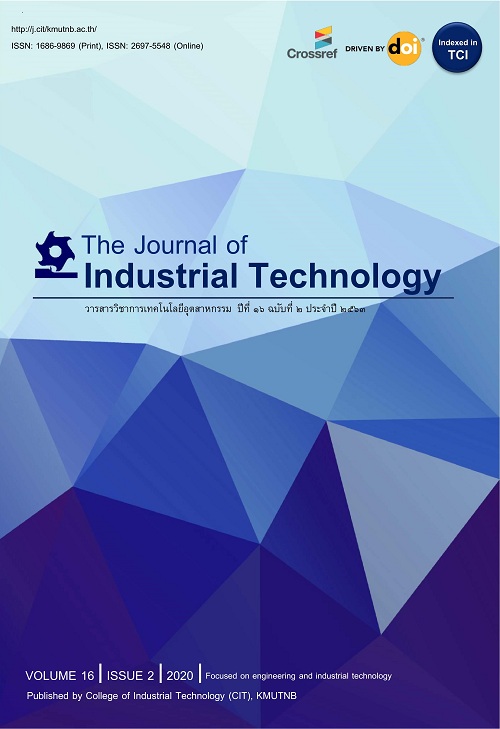Polypropylene Biodegradation by Fictibacillus phosphorivorans Isolated from Freshwater Sediment
การย่อยสลายพลาสติกพอลิโพรพิลีนโดย Fictibacillus phosphorivorans ที่แยกจากตะกอนดินน้ำจืด
Abstract
พลาสติกที่สังเคราะห์ด้วยปิโตรเคมีได้รับความนิยมในการนำมาใช้ประโยชน์อย่างแพร่หลายทั้งในอุตสาหกรรมและการใช้ในชีวิตประจำวัน ซึ่งพอลิโพรพิลีนเป็นชนิดหนึ่งที่มีการใช้และตกค้างสะสมในระบบนิเวศปริมาณมาก เนื่องจากโครงสร้างพอลิเมอร์และการใช้สารเติมแต่งในกระบวนการผลิตจึงทำให้พอลิโพรพิลีนถูกย่อยสลายได้ยากโดยวิธีการทางชีวภาพ การศึกษาในครั้งนี้สามารถแยกเชื้อแบคทีเรียจากตะกอนดินบ่อน้ำภายในมหาวิทยาลัยราชภัฏพระนครศรีอยุธยา และเมื่อทดสอบ Drop Collapse Test พบว่า ไอโซเลต T2 สามารถผลิตสารลดแรงตึงผิวทางชีวภาพได้ จึงนำมาศึกษาการย่อยสลายพอลิโพรพิลีนโดยเพาะเลี้ยงในอาหาร Bushnell Haas (BH) ที่มีชิ้นส่วนพลาสติกเป็นเวลา 30 วัน พบว่า น้ำหนักของชิ้นส่วนพลาสติกหายไปคิดเป็น 10.25% นอกจากนี้ยังพบว่า พื้นผิวของพลาสติกมีลักษณะขรุขระเมื่อศึกษาภายใต้กล้องจุลทรรศน์อิเล็คตรอนแบบส่องกราด ซึ่งเกิดจาก การย่อยสลายทางชีวภาพโดยแบคทีเรีย จากการศึกษาสายพันธุ์ของแบคทีเรียไอโซเลต T2 ด้วยการวิเคราะห์ข้อมูลลำดับนิวคลีโอไทด์บริเวณ 16S rRNA ร่วมกับการศึกษาความสัมพันธ์ทางลำดับวิวัฒนาการ พบว่ามีความใกล้เคียงกับสายพันธุ์ Fictibacillus phosphorivorans ซึ่งยังไม่พบรายงานการย่อยสลายพลาสติกพอลิโพรพิลีนมาก่อน ทั้งนี้พบว่า ผลจากการทดลองสามารถพัฒนาสายพันธุ์แบคทีเรียด้วยกระบวนการและเทคโนโลยีที่เหมาะสมเพื่อใช้ในการบำบัดสิ่งแวดล้อมที่มีการสะสมปนเปื้อนของพลาสติกได้ต่อไปในอนาคต
Petroleum-based plastic is widely used either in extensive industrial or daily applications. Polypropylene is mostly used and accumulate in large quantities in the ecosystem. Due to the polymeric structure and supplemented additives in the production process, resulted in rare biodegradation of polypropylene. In this study, the total bacteria were isolated from freshwater sediment within Phranakorn Si Ayutthaya Rajabhat University. The biosurfactant production has been observed in the bacteria isolate T2 after the Drop collapse test procedure. Polypropylene biodegradation efficiency was then investigated through the cultivation of the isolate T2 in the Brushnell Haas (BH) media composed of plastic sample for 30 days, yielding the plastic weight loss of 10.25%. In addition, the roughness of the plastic surface was occurred during SEM analysis provided evidence of bacterial biodegradation proceeded. According to the 16S rRNA sequencing and phylogenetic analysis, the bacteria isolate T2 was closely related to Fictibacillus phosphorivorans which had not previously been reported to polypropylene plastics biodegradation. Hence, the result would be a considerable development of bacterial strain through an appropriate process and technology regarding to the further remediating environment contaminated with plastics.
Keywords
[1] A.L. Andrady and M.A. Neal, Applications and societal benefits of plastics, Philosophical Transactions of the Royal Society B, 2009, 364(1526), 1955-1984.
[2] Z. Cai, M. Li, Z. Zhu, X. Wang, Y. Huang, T. Li, H. Gong and M. Yan, Biological degradation of plastics and microplastics: A recent perspective on associated mechanisms and influencing factors, Microorganisms, 2023, 11, 1661.
[3] G. Lear, J.M. Kingsbury, S. Franchini, V. Gambarini, S.D.M. Maday, J.A. Wallbank, L. Weaver, and O. Pantos, Plastics and the microbiome: impacts and solutions, Environmental Microbiome, 2021, 16(2), 1-19.
[4] A. Tareen, S. Saeed, A. Iqbal, R. Batool and N. Jamil, Biodeterioration of microplastics: A promising step towards plastics waste management, Polymers, 2022, 14(11), 2275.
[5] J.M. Jeon, S.J. Park, T.R. Choi, J.H. Park and Y.H. Yang, Biodegradation of polyethylene and polypropylene by Lysinibacillus species JJY0216 isolated from soil grove, Polymer Degradation and Stability, 2021, 191, 109662.
[6] Y. Tokiwa, B.P. Calabia, C.U. Ugwu and S. Aiba, Biodegradability of plastics, International Journal of Molecular Sciences, 2009, 10(9), 3722-3742.
[7] S.Y Ren. and H.G Ni, Biodeterioration of microplastics by bacteria isolated from mangrove sediment, Toxics, 2023, 11(5), 432.
[8] N. Mohanan, Z. Montazer, P.K. Sharma and D. B. Levin, Microbial and enzymatic degradation of synthetic plastics, Frontiers in Microbiology, 2020, 11, 580709.
[9] Y. Zheng, E.K. Yanful, and A.S. Bassi, A review of plastic waste biodegradation, Critical Reviews in Biotechnology, 2005, 25(4), 243-250.
[10] A.F. Samat, D. Carter and A. Abbas, Biodeterioration of pre-treated polypropylene by Aspergillus terreus and Engyodontium album, npj Materials Degradation, 2023, 7, 28.
[11] H.S. Auta, C.U. Emenike, B. Jayanthi and S.H. Fauziah, Growth kinetics and biodeterioration of polypropylene microplastics by Bacillus sp. and Rhodococcus sp. isolated from mangrove sediment, Marine Pollution Bulletin, 2018, 127, 15-21.
[12] N. Shimpi, M. Borane, S. Mishra, M. Kadam and S.S. Sonawane, Biodegradation of isotactic polypropylene (iPP)/poly(lactic acid) (PLA) and iPP/PLA/nano calcium carbonates using Phanerochaete chrysoporium, Advances in Polymer Technology, 2018, 37(2), 522-530.
[13] S. Skariyachan, N. Taskeen, A.P. Kishore, B.V. Krishna and G. Naidu, Novel consortia of Enterobacter and Pseudomonas formulated from cow dung exhibited enhanced biodegradation of polyethylene and polypropylene, Journal of Environmental Management, 2021, 284, 112030.
[14] A.S. Dey, H. Bose, B. Mohapatra and P. Sar, Biodegradation of unpretreated low-density polyethylene (LDPE) by Stenotrophomonas sp. and Achromobacter sp., isolated from waste dumpsite and drilling fluid, Frontiers in Microbiology, 2020, 11, 603210.
[15] S. Habib, A. Iruthayam, M.Y. Abd Shukor, S.A. Alias, J. Smykla and N.A. Yasid, Biodeterioration of untreated polypropylene microplastic particles by antarctic bacteria, Polymers, 2020, 12(11), 2616.
[16] N. Tabburee, W. Tantipanathip and P. Eiamsa-ard, Microplastic contamination in freshwater sediment within Phranakhon Si Ayutthaya Rajabhat Uneversity, ARU Journal Science and Technology, 2022, 4(1), 56-65. (in Thai).
[17] N. Panjiar, S.G. Sachan and A. Sachan, Screening of bioemulsifier-producing micro-organisms isolated from oil-contaminated sites. Annals of Microbiology, 2015, 65, 753-764.
[18] S.M. Shagufta and P.V. Dharani, Screening and isolation of bacteria producing biosurfactants from Waste, Journal of Pure and Applied Microbiology, 2022, 16(1), 567-577.
[19] S. Ali, A. Rehman, S.Z. Hussain and D.A. Bukhari, Characterization of plastic degrading bacteria isolated from sewage wastewater, Saudi Journal of Biological Sciences, 2023, 30(5), 103628.
[20] E. Kaczorek, A. Pacholak, A. Zdarta and W. Smulek, The impact of biosurfactants on microbial cell properties leading to hydrocarbon bioavailability increase, Colloids Interfaces, 2018, 2(3), 35.
[21] R. Kavitha and V. Bhuvaneswari, Assessment of polyethylene degradation by biosurfactant producing ligninolytic bacterium, Biodegradation, 2021, 32(5), 531-549.
[22] N. Nehal and P. Singh, Optimization of cultural condition of Bacillus sp. MZ540316: Improve biodegradation efficiency of lipopeptide biosurfactant against polyethylene, Biomass Conversion and Biorefinery, 2023, 13, 15471-15487.
[23] J. Ru, Y. Huo and Y. Yang, Microbial degradation and valorization of plastic wastes, Frontiers in Microbiology, 2020, 11, 442.
[24] H.S. Auta, C.U. Emenike and S.H. Fauziah, Screening of Bacillus strains isolated from mangrove ecosystems in Peninsular Malaysia for microplastic degradation, Environmental Pollution, 2017, 231, 1552-1559.
[25] H. Nakatani, Y. Ohshima, T. Uchiyama and S. Motokucho, Degradation and fragmentation behavior of polypropylene and polystyrene in water, Scientifc Reports, 2022, 12(1), 18501.
[26] R. Pandey, P. Sharma, S. Rathee, H.P. Singh, D.R. Batish, B. Krishnamurthy and R.K. Kohli, Isolation and characterization of a novel hydrocarbonoclastic and biosurfactant producing bacterial strain: Fictibacillus phosphorivorans RP3, 3 Biotech, 2021, 11(2), 105.
DOI: 10.14416/j.ind.tech.2024.04.009
Refbacks
- There are currently no refbacks.






